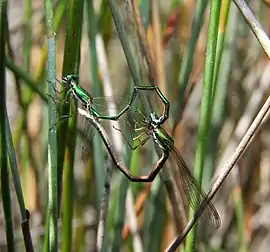Hemiphlebiidae
Hemiphlebiidae is a family of damselflies, it contains only one extant species, the ancient greenling, native to Southern Australia and Tasmania. The fossil record of the group extends back to the Late Jurassic.
| Hemiphlebiidae | |
|---|---|
 | |
| Hemiphlebia mirabilis | |
| Scientific classification | |
| Kingdom: | Animalia |
| Phylum: | Arthropoda |
| Class: | Insecta |
| Order: | Odonata |
| Suborder: | Zygoptera |
| Family: | Hemiphlebiidae Kennedy, 1920 |
| Genera | |
|
See text | |
Taxonomy
- †Burmahemiphlebia Zheng et al. 2017 Burmese amber, Myanmar, 99 Ma[1]
- †Electrohemiphlebia Lak et al. 2009 Charentese Amber, France, 105-99 Ma[2]
- †Enteropia Pritykina and Vassilenko 2014 Shar Teg, Mongolia, 145 Ma.[3]
- Hemiphlebia Selys, 1869, Australia, Extant.
- †Jordanhemiphlebia Kaddumi 2009 Jordanian Amber, Jordan, 112.6 to 99.7 Ma[2]
- †Kachinhemiphlebia Zheng 2020 Burmese amber, Myanmar, 99 Ma[4]
- †Mersituria Vasilenko 2005 Doronino Formation, Russia, 130 to 125 Ma.[5]
- †Pantelusa Vassilenko 2014 Ora Formation, Israel, 94.3 - 89.3 Ma[6]
- †Parahemiphlebia Jarzembowski et al. 1998 Durlston Formation, United Kingdom 145-140 Ma[7] Crato Formation, Brazil 122-112 Ma.[8]
- †Thairia Felker and Vasilenko 2018 Doronino Formation, Russia, 130 to 125 Ma.[9]
References
- Zheng, Daran; Zhang, Qingqing; Nel, André; Jarzembowski, Edmund A.; Zhou, Zhicheng; Chang, Su-Chin; Wang, Bo (2016-05-18). "New damselflies (Odonata: Zygoptera: Hemiphlebiidae, Dysagrionidae) from mid-Cretaceous Burmese amber". Alcheringa: An Australasian Journal of Palaeontology. 41 (1): 12–21. doi:10.1080/03115518.2016.1164402. ISSN 0311-5518. S2CID 89353025.
- LAK, MALVINA; FLECK, GÜNTHER; AZAR, DANY; ENGEL FLS, MICHAEL S.; KADDUMI, HANI F.; NERAUDEAU, DIDIER; TAFFOREAU, PAUL; NEL, ANDRÉ (August 2009). "Phase contrast X-ray synchrotron microtomography and the oldest damselflies in amber (Odonata: Zygoptera: Hemiphlebiidae)". Zoological Journal of the Linnean Society. 156 (4): 913–923. doi:10.1111/j.1096-3642.2008.00497.x. ISSN 0024-4082.
- L. N. Pritykina and D. V. Vassilenko. 2014. Odonata, in Upper Jurassic Lagerstätte Shar Teg, southwestern Mongolia. Paleontological Journal 48:1641-1647
- Zheng, Daran (September 2020). "Odonatans in lowermost Cenomanian Kachin amber: updated review and a new hemiphlebiid damselfly". Cretaceous Research: 104640. doi:10.1016/j.cretres.2020.104640.
- D. V. Vasilenko. 2005. New Damselflies (Odonata: Synlestidae, Hemiphlebiidae) from the Mesozoic Transbaikalian Locality of Chernovskie Kopi. Paleontological Journal 39(3):280-283
- D. V. Vassilenko. 2014. The first damselfly (Insecta: Odonata, Hemiphlebiidae) recorded from the Turonian of Israel. Far Eastern Entomologist 278:1-7
- Jarzembowski, E.A.; Martı́nez-Delclòs, X.; Bechly, G.; Nel, A.; Coram, R.; Escuillié, F. (June 1998). "The Mesozoic non-calopterygoid Zygoptera: description of new genera and species from the Lower Cretaceous of England and Brazil and their phylogenetic significance (Odonata, Zygoptera, Coenagrionoidea, Hemiphlebioidea, Lestoidea)". Cretaceous Research. 19 (3–4): 403–444. doi:10.1006/cres.1997.0113. ISSN 0195-6671.
- G. Bechly. 1998. New fossil dragonflies from the Lower Cretaceous Crato Formation of north-east Brazil (Insecta: Odonata). Stuttgarter Beiträge zur Naturkunde Serie B (Geologie und Paläontologie) 264:1-66
- A. S. Felker and D. V. Vasilenko. 2018. A new genus and species of the damselfly family Hemiphlebiidae from the Lower Cretaceous Chernovskie Kopi locality (eastern Transbaikalia). Paleontological Journal 52:142-145
This article is issued from Wikipedia. The text is licensed under Creative Commons - Attribution - Sharealike. Additional terms may apply for the media files.